Understanding the latest advances in digital dentistry
Digital Esthetics unpacks the latest and most innovative developments in digital dentistry.
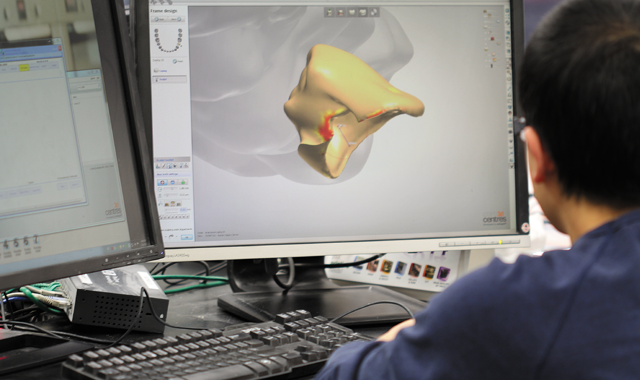
When smartphones came out about a decade ago, they were a novelty. It was fun to have the internet in your pocket. It was cool to have pictures and movies at your fingertips. But smartphones have moved beyond mere novelty and are now a necessity.
Such is the case with CAD/CAM and digital dentistry. A decade ago, it was unique for labs to be able to produce restorations using a scanner, computer and mill. Now, however, it is becoming necessary for the business. The new workflows made possible because of this technology are likely to become standard in the very near future.
Workflow
Maturing new workflows depends on a number of factors, not just technology. While introducing a feature-rich CAD/CAM system is important, new workflows depend on other components all working together.
What is Digital Esthetics? Click here to find out.
“Dentistry used to be a materials-oriented industry, and today the process evolution is just as important as the materials,” says Dr. George Tysowsky, Senior Vice President of Technology at Ivoclar Vivadent. “We’re looking not only at how to make a stronger material, or a more polishable material, or a more esthetic material, but what’s the entire process that can streamline the development of that restoration in a more effective fashion? Digital technology plays a very, very critical role in that. When we have R&D teams now, it’s not just material science people, it’s process people who look at the combination of the whole picture of what’s the chemistry, what’s the material, what is the most effective process for final fabrication?”
Digital materials are making esthetics and strength more reliable than ever (photo courtesy of CAP; taken by Lucas T. Lammott, Director of Dental Technologies and owner of M31 Dental Studio.).

Both doctors and labs can get as deeply into the digital world and embrace whatever workflows that their interests-and budgets-allow.
“As the growth occurs, people have jumped fully in and adopted full-digital technology,” Dr. Tysowsky says. “There are those who are a master at the top level, doing a majority of the restorations with it. Others use connected systems where they might transfer information to laboratories or do posteriors only, and for anteriors they may use traditional labs. And the people entering the market today want to get into digital technology, but maybe doing scanning only to try and integrate. If they get comfortable with it, they can always expand and get into full automation and CAD/CAM and milling in their own offices.”
Labs that need to embrace more of a digital workflow than they are prepared for can find help in partnering with a milling center, like Core3dcentres for instance.
Step-by-step technique: How going digital can revolutionize your esthetic possibilities
“If they have a scanner but no milling capability, they can send us their designs and we can mill it,” says Jason Atwood, CDT, Senior Digital Solutions Adviser, Core3dcentres. “If people want to get into their own milling, there are a lot of different options. The only advice I would give is that you should do your research and only invest as much as will provide you with the needs that your lab has currently. A large investment, sometimes, is a little bit scary, and in a lot of cases not necessary, because the cost for maintaining these machines and hiring the right people to run them can be offset by sending to a milling center.”
The new workflows that digital dentistry makes possible, ultimately, benefit the patient.
“Some of the new developments we have made in the most recent past have really helped in cutting the number of office visits for patients down and the amount of time they have had to spend in the chair,” says Adrienne Slevin, CAD Specialist/Trainer for DAL DT Technologies. “It has also increased the predictability factor. Doctors and patients can now view everything before it is manufactured, increasing everyone’s satisfaction.
New and improved
New workflows made possible with CAD/CAM technology include previously impossible things like digital dentures, model-less crowns and custom-designed implants.
Step-by-step: A better screw-retained zirconia prosthesis
“Digital dentures are the only major indication that is not covered by CAD/CAM,” says Rune Fisker, Vice President of Product Strategy at 3Shape. “We really see a big change coming there. Digital dentures are going to take off, if not this year then for sure next year. And it’s not just to allow labs to make a cheaper denture, but it also allows them to reduce the number of patient visits. Digitization allows you to take a number of steps in one goal, so rather than five visits, you might be able to reduce the total number of visits to three and likely even two. Worldwide, digital dentures are the hottest thing; the hottest workflow.”
Desigining with software allows immediate visibility of what the finished result will be (photo courtesy of Vulcan Custom Dental).

Implant quality and placement is enhanced by digital dentistry and the overall outcomes are improved.
“One of the things I’m seeing is how doctors whose practices are based off of referrals are looking to enhance what they’re doing for their referral base,” says Mark Ferguson, General Manager, Vulcan Custom Dental. “So we’re seeing implant surgeons that are sending the patient back with an abutment already placed so that the referring doctor, who may not be comfortable with handling tiny little screws in the patient’s mouth or something like [that], for them it’s now just right back into their wheelhouse of cementing a crown on a prep.”
One of the promises of digital dentistry is the ability to create and produce a crown, all within the CAD/CAM system. It’s certainly nothing new, but Atwood expects it to explode in popularity.
“I think the next shift-and it’s already begun-that’s going to be standard practice very soon is what we’re calling model-less crowns,” Atwood says. “Where a patient can go in, get an intraoral scan and the crown and everything can be designed virtually, manufactured virtually with confidence, and sent back for immediate insertion without ever producing a model.”
Scanning
Digital workflows start at scanning-either at the doctor’s office with an intraoral scan or in the lab when a model or an impression is scanned. With intraoral scanners becoming increasingly affordable, more doctors will use the technology, and labs need to be prepared to handle those cases.
“We have data that suggests that 39 percent of all dentists are going to buy an intraoral scanner in the next three years, and of course [that will] have a tremendous impact on the way labs work today, because, suddenly, one third of their jobs will come in on an intraoral scan in a digital file rather than a conventional impression,” Fisker says.
On the lab side of scanning, Bob Cohen, CDT, President at Custom Automated Prosthetics notes that technology advancements are improving what labs are able to work with.
Incredible results with digital tools (photo courtesy of Dental Arts Laboratory).
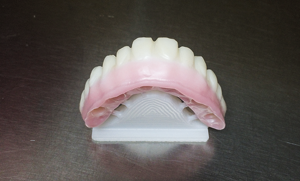
“Desktop scanner manufacturers have been working to perfect impression scanning,” Cohen says. “It is far more difficult to scan an impression as compared to a model. That said, a scanner that can scan all analog impressions can shorten manufacturing cycles as it enables simultaneous parts of manufacturing. Through impression scanning, for the first time, one can also implement model-free workflows in conjunction with analog impressions. This will offer labs that embrace these scanners a competitive advantage with a same-day or next-day crown while eliminating the cost of model production.”
Scanning technologies not only provide the starting point for digital workflows, but they can also connect well with other components, allowing for more opportunities.
Step-by-step: How digital tools make global collaboration a reality
“Open intraoral scanners are creating additional opportunities for connections to low-cost mills which could increase the proliferation of chairside systems and the cost of procuring them for the dentists,” says Jim Buchanan, Director of National Accounts at 3M ESPE. “Overall, there will be more seamless integration of the various devices and software allowing greater flexibility and workflow options for dentists and labs.”
Another advancement in scanning that help with new workflows is cone beam (CBCT) scanning. The CBCT scan gives doctors a better look at the patient’s anatomy, which helps with things like implant placement.
“CBCT becomes a really important piece, because when you can treatment plan virtually in 3D for implant cases and that sort of thing, that is definitely a time saver,” says Dr. John Flucke, DDS, Technology Editor for Dental Products Report. “That saves you a great deal of time, because when you do the surgical piece of it, and you can just sit down and pick up the handpiece and do the surgical piece of it in less time than you were doing it before.”
Design
Software innovations continue to occur, making the process of restoration design faster and more feature-rich.
“The software has evolved tremendously, so we have new libraries,” Dr. Tysowsky says. “The software is much more user-friendly. We have the copy systems, where they actually have libraries or can judge adjacent and proximal dentition to replicate the anatomy. It’s tremendously evolved from[when the] majority of the work was to design the restoration by oneself. The software can really do it all for you, and if you need to modify it, you certainly have that flexibility.”
Cases that used to rely on rudimentary techniques can now be fully digitally realized (photos provided by 3M and created by Dr. Robert Ritter of Techsource Dental; the case was scanned on iTero, designed on exocad and manufactured by Techsource Dental).
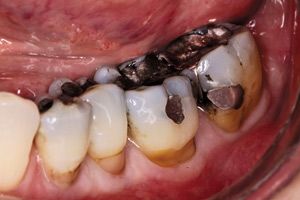
Cases that used to rely on rudimentary techniques can now be fully digitally realized (photos provided by 3M and created by Dr. Robert Ritter of Techsource Dental; the case was scanned on iTero, designed on exocad and manufactured by Techsource Dental).
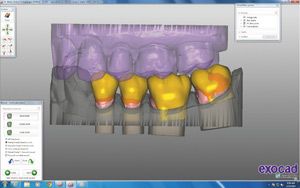
The continually evolving capabilities of CAD not only make the work easier, but they give labs opportunities for new income sources.
“CAD has become incredibly efficient,” Cohen says. “Designing a crown in just three or four minutes or just 20ish mouse clicks can be accomplished very easily. I expect initial CAD proposals to continue to get closer to the desired final contour, which will continue to reduce time and cost of design. Other CAD developments are likely to continue with new indications. For instance, 3Shape recently released Implant Studio software. This new module enables labs and/or dentists to simply merge a CBCT scan and a surface or model scan to plan implant-placement based on bone morphology and final restoration tooth placement. The software also designs surgical guides based on the plan, very quickly, outputting an STL file for milling or printing the final surgical guide. Interestingly, it appears that most dentists that place implants don’t want to spend the time to learn the software nor take the time to do the plan. That said, this is a great opportunity for labs to offer a new very profitable service that will also generate new implant business.”
Speed enhances lab efficiency, of course, but the end result is what really matters.
“Certainly we’re able to digitally design more complex cases than we were five, 10 years ago,” Ferguson adds. “It seems like the CAD software manufacturers who are trying to get the simple cases down to the least number of clicks, rather than trying to say, ‘Well, five clicks versus six clicks, for a simple coping, doesn’t really make a difference, but if my software can do a 10-unit case or a 14-unit case, as opposed to just a two- or three-unit case, then that really improves my software over the competition.’ I think more and more companies have gotten down to their least number of clicks, so now they’re really interested in adding improved capabilities. The side benefit of that is that higher-end technicians that were previously doing cases that may not have been able to be done in CAD, because the CAD just couldn’t do a full-mouth, now they’re saying, ‘Okay, my CAD software can do a full-mouth now. I can start to incorporate a digital workflow.’”
Complex cases become easier to design and produce.
“I expect that 100 percent of the work will be done digitally from the moment the order notification hits the lab,” Slevin notes. “An example of how digital is a welcome relief to doctors and technicians: Say we have different indications such as telescopic copings, a huge pressed zirconia bridge all under an existing partial, a crown and an abutment, and the prep or opposing needs relieved, and maybe a night-guard-all on the same jaw. It is actually possible, and not intimidating, and communication is a breeze; it can be designed and fabricated quickly, and all with one scan, and all at the same time.”
Manufacturing
Advancements in the world of manufacturing are also making new workflows exhilarating. While milling has been the chief way to produce CAD/CAM-based restorations, newer technologies are poised to bring even more capability.
“Milling manufacturing pretty much is what it is,” Ferguson says. “We can add another axis to a machine, but we’re really limited with milling when it comes to the material. You can really only mill a material as fast as you can mill it, and those variables are already known. If I try to mill titanium too fast, I’m either going to damage the titanium or damage the tool that I’m using. Where I see a lot of really exciting development is the additive manufacturing, whether it be laser printing, SLM or SLA, [and how] the material manufacturers are coming out with more materials. They’re coming out with more versatile machines to mimic, say, an inkjet printer, where you have three or maybe five different colors of ink, but you’re still able to print full-color photos by the software being able to blend those different colors together. As that moves into more dental materials that are actually suited to go in the mouth, that’s going to really knock the doors off our field.”
Even a single crown can be a work of art (photo courtesy of Ivoclar Vivadent).
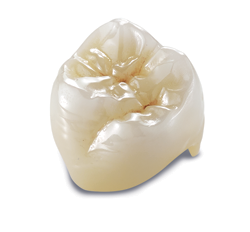
While milling machines have experienced fantastic advancements over the past decade, Cohen expects to see the same with 3D printers.
“From a hardware perspective, we have gone through five years of advancement for better, cheaper milling machines, thanks to rapidly proliferating digital intelligence,” Cohen says. “The rapid rate of mill improvement has been amazing. Laboratories using mills that are eight- to 10-years-old are likely working with obsolete, antiquated technology. Today, there is evidence of the same evolution for 3D printing. Competition is heating up in the printer market and this is good for dentistry.”
How 3D printers handle materials will also be an important factor in their utility.
“Materials for different indications can be put in the same machine,” Fisker notes. “Some years ago, there was one machine that could print wax, and one machine that could print a model, or maybe a guide, and now you see the same machines able to print a whole range of different materials. It makes it much more feasible to use 3D printing.”
Fisker expects the prices for 3D printers to come down even further, bringing the machines within reach of more labs.
“3D printing is coming full-speed,” Fisker says. “The printers have dropped in price. We see them now at $25,000 where three years ago they were $50,000, and we think they’re going to go below $20,000 in one to two years-maybe even below that.”
Esthetics
If restorations don’t look like real teeth, they are of little use. Happily, esthetics have enjoyed a huge boost in quality. But in order to take advantage of those benefits, technicians have to keep pace.
“The ability of the CAD and the CAM and what they’re able to accomplish with design are more advanced than the operators are right now,” says Dr. Michael Gaglio, Senior Vice President of Marketing & Digital Communication for Ivoclar Vivadent. “What has to happen is that the operators have to catch up with the technology, because the CAD software just has so many opportunities for creating predictable ideal esthetics and form-almost more so than the traditional analog approach.”
Using the right tools and CAM software can ensure better results (photo courtesy of Core3dcentres).
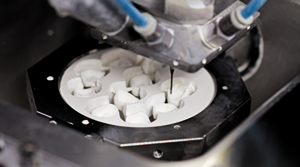
Esthetics advances aren’t just occurring on one front-they are coming from all sides and expected to deliver even more abilities in the future.
“3D facial scanning, available now, will become better integrated into CAD software, so designers will, for the first time, perform design into the face and lips of our patients,” Cohen says. “3D printing and intraoral scanners will become much more mainstream. Materials for printing will improve. We will likely see a printable final restoration. [Intraoral scanning] devices have come down in price, have become considerably easier to use, are smaller, powder-free, and have added efficiencies to workflows that are simply not obtainable with analog impressions and will help drive adoption.”
Ultimately, it is up to the person at the computer-not the machines-to deliver the best esthetic results.
“The instrumentation has contributed tremendously, but still we have to rely on artistry,” Dr. Tysowsky says. “We can create monolithic restorations, but there are various grades of the clinician or the technician that’s operating the system that has to judge whether it meets the final requirement, and it won’t require as much effort, but may require some fine-tuning or adjustment to provide the optimum characteristics and final esthetic result.”
Materials
Technology isn’t solely responsible for advances in digital dentistry workflows. Materials, too, must be appreciated.
“Never before has the world of dentistry seen such beautiful zirconia that has not sacrificed esthetics,” Slevin says. “Reliability comes into play by the technology that the doctor and laboratory use in the process of designing these units. Also, being able to overlay images of the patient’s existing smile and desired smile into the design process increases the desired esthetics for the patient.”
Intraoral scanning brings the entire dental workflow into the digital future (photo courtesy of 3Shape).
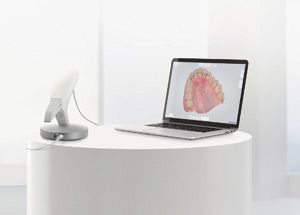
The monolithic materials used by digital dentistry continue to improve, and are now stronger and more esthetic than before.
“We are seeing a movement from layered restorations to monolithic restorations mostly made up of either lithium disilicate or zirconia,” Buchanan says. “Because of its strength and most recently its increased translucency, we are seeing monolithic zirconia restorations prescribed at an increasing rate. While mostly used in the posterior in past years, high translucency zirconia available to labs today is used for both anterior and posterior restorations. Now dentists can have a highly esthetic restoration with the strength benefits provided by zirconia.”
As good as the materials are, they must continue to evolve in order to keep pushing new workflows forward.
“What has to complement it are new material developments,” Dr. Gaglio says. “Today, monolithic is the big buzz in the world, because, obviously, monolithic leads to the best strength, but how do you create layered esthetics in a monolithic material? That requires material developments that build-in lifelike esthetics into a monolithic format. While both digital equipment and materials are equally important, they have to develop almost hand-in-hand in order for the overall process to be enhanced.”
Evolving materials are improving strength, quality, and esthetics.
“Esthetics wise, it’s impossible to get around the materials,” Fisker notes. “Of course, it is CAD/CAM materials that have changed it, so in that sense it is driven by CAD/CAM. For the first time we’ve seen more monolithic crowns now than we see PFM or hand-veneering. Is that improving the esthetics? I will say that the inexpensive crowns are getting much higher esthetics, especially the full high translucency zirconia, than it did just two years ago. Of course [pressing] still remains strong, but hand-veneering we believe is going to disappear.”
While restorations can be designed and manufactured with great levels of detail and esthetics, it is useless unless there are materials to produce the cases. Those materials continue to evolve.
“Material science development will continue to deliver more lifelike, stronger materials,” Cohen says. “For instance, next-generation zirconia discs will be multicolored and have multi-translucencies, and will be the most lifelike monolithic material to date. I believe this material will become the standard of care for the vast majority of crowns.”
Materials are not only more esthetic and reliable, but they are faster to produce.
“From a processing perspective, we have gone from a nine-hour sintering cycle to just two hours, saving over 75 percent of the time originally needed to sinter,” Cohen continues. “Through further zirconia development, this cycle is likely to continue to become shorter, making same-day zirconia crown even more of a reality. If this remains a barrier I would expect a flow of new materials that is not yet available. Another alternative is milling a pre-sintered zirconia block. Glidewell has launched a mill and BruxZir blocks that facilitate milling fully sintered zirconia, although this is fairly expensive solution. The solution, BruxZir Now, includes the mill, tools and sintered BruxZir blocks.”
Doctor’s POV
Many of the new workflows either stem from or directly affect the clinician. Dr. Flucke says the ability to communicate and collaborate with his lab generates better results, because they can discuss cases in real time.
“It’s a great benefit when you can call and you can say things like, ‘We just took the impression and what do you think of the lingual margin,’” says Dr. Flucke. “When I’ve got a situation that either I’m not sure of, or I’m not sure of ‘will this work,’ or I’m not sure about pushing the envelope with this one, I rely on the lab to tell me their ideas and, pardon the pun, their impression of what I’m doing.”
It also affords the opportunity to avoid problems before they actually become problems. Dr. Flucke recounts a case that his lab previously had a bad experience with and was able to share their results before the case was finally produced.
“I had had a situation when I first started doing lithium disilicate, and I sent out a bridge to be done, and my lab had done 10 very similar cases that year,” Dr. Flucke remembers. “They said every one of them broke. ‘We just want you to know about that ahead of time. We’ll do it for you if you want us to, but we just want you to be aware of this is what we’ve seen.’ And I love that interaction, because they see things like that that I don’t see. They see the failures and learn about the failures, and I only learn about my failures.”
The workflows made possible by digital dentistry make that immediacy possible.
“When they can look right at an impression on the screen, and say, ‘I wouldn’t do that if I were you,’ and I’ve just sent it to them, stopping and reprepping or choosing a different material is a whole lot easier when you’re dealing with digital stuff than with analog things,” Dr. Flucke continues. “In the analog world, by the time the lab gets the case, it’s the next day-if you’re lucky. And the one thing is-I can guarantee you-that the patient is not still in my office not still anesthetized. When you’re digital, the lab can make a recommendation, and I can make the needed changes right there at the chair. The patient is still anesthetized, so it makes it easier all the way around, as opposed to having to get the patient back, having to get re-anesthetized, which patients certainly don’t like; doctors don’t like; assistants don’t like.”
Collaboration
A fantastic attribute of digital dentistry and its ability to usher in new workflows is the overall ease of communication and collaboration. Doctors and their labs; labs and their milling centers; and even doctors and specialists can easily work together on cases on their office computers, and in some cases right on their smartphones.
“Doctors are busy and now, at their convenience, they can see a design, use measurement tools, ask any questions at a time that fits into their lives,” Slevin says. “I see more and more texting as well-just a quick text to let you know that contacts or occlusion have been great, but maybe a margin was a bit bulky or ‘Patient Jones couldn’t make the appointment set, can we get it sooner?’”
Buchanan encourages labs to provide more service and value for their doctors.
“Many labs now realize that they need to be more than just a supplier of crowns for the dentist if they are to retain present customers and attract new customers,” Buchanan notes. “Dentists look to the labs as a trusted advisor for information around new digital technologies, new workflows, and material innovations for use in the traditional crown and bridge procedure. Overall, labs will begin to be challenged to take on the role of manufacturing partner to help the dentist increase their chairside productivity through consistency in the product they provide, turnaround time, and esthetics. Digital workflows could help both the dentist and lab work more efficiently, removing many of the variables that are present in an analog crown and bridge workflow, which can lead to inconsistency and ultimately more chair time for the dentist or continued remakes.”
One example of a communication and collaboration system is 3Shape Communicate. It is a system in which everyone involved in the case is able to use the same tool to collaborate.
“[There is the] TRIOS scanner, of course, but [3Shape is] integrating it with the lab scanner, with the milling center, with everything so that the user interface is the same for everyone involved, which is pretty exciting,” Atwood says. “It’s a dental desktop that is an interface that the doctor can use, the lab can use, and it has all of the patient information and it translates into any of the different stages of the workflow. So when the patient goes to the dentist, he can do case planning there, and they can do the intraoral scanning there, and then they can electronically send all of that information to the lab, where they can digitally design the restorations and then send it back to the doctor for approvals, where the doctor can see the 3D model and show the patient. They get the patient to see, on-screen, what they would look like with the new restorations. And then once the approvals are given from the doctor and the patient, that information can then be sent directly to the milling center, where they can fabricate, and then it all gets shipped back to the doctor. It just makes it fairly seamless to go from one stage to another stage and back again.”d
Fisker notes that some labs are reaping the benefits of digital dentistry for their collaborative efforts.
“Albensi Lab last year sent more than 1,000 cases for design preview to their dentists,” Fisker syas. “It was a conventional scan, and now they can send it for design preview so the dentist can look at the design, and this way they can improve the design and comment on it. This is really the future, that labs should be focused so much more on service and working closely with the dentist, and actually communicating on cases. This is why we call it 3Shape Communicate. It’s because it is meant for case communication, not just connecting the lab and the doctor. It’s extremely important for labs to communicate more.”
But there is a fatal flaw in the current age of collaboration-people have to be involved and actually use the tools available to them.
“The drawbacks to collaboration right now is the human not actually reaching out,” Ferguson says. “Digitally, there are tools out there, whether it be BrightSquid for HIPAA-compliant sharing of large data files and team-building within that software, or just any cell phone right now [where] you can download a free STL viewer. Sometimes I think people get worried about collaboration because they get worried that somebody’s going to tell them that they need to fix something.”
The future
There’s no way to get around it: CAD/CAM will continue to evolve and be a major influence in dentistry.
Because it will be so omnipresent, Fisker believes that it will make the business of being a dental lab more competitive, and change the way labs need to serve their doctors.
“Because people have more or less the same CAD/CAM systems, more or less the same materials,” Fisker says, “there will be also more price pressure because full-zirconia prices will be falling. Effectively, this means there will be more competition, so it’s more important that the labs move from being production labs to service labs, because if they’re just a production lab, there will always be another lab that is cheaper than you. [Labs] should really think to add services for the dentist-things like sharing knowledge for treatments.”
“Digital is the future right now, but it’s not just the future of dentistry-it’s the future of all industry today,” Dr. Gaglio says. “And maybe it’s a cliché or a buzz word-the word ‘digital’-but digital really relates to technology efficiencies and movement in a direction of manufacturing or production that allows for a smoother, more predictable outcome.”